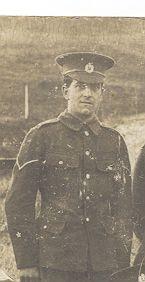William Arthur DATLEN
26th Feb 18911,2 - 24th Oct 1964
Improver to Blacksmith & Farrier
Life History
1891 |
Resident in 19 Limekiln Street, Dover, Kent, England.2 |
26th Feb 1891 |
Born in Dover, Kent, UK..1,2 |
26th Feb 1894 |
Note in Alternative birth date |
1901 |
Resident in 52 Longfield Road, Dover, Kent, England.1 |
1909 |
Occupation Blacksmith employed by Mr A Partridge |
1909 |
Physical description 35 inch chest; 5 feet 4 inches tall |
1909 |
Resident in 14 Leyton Road, Dover, Kent, England |
1911 |
Occupation Improver to Blacksmith & Farrier |
1911 |
Resident in 23 Tower Hamlets, Kent, England |
26th Dec 1914 |
Married Mabel FOGG in Dover, Kent, England |
about 1916 |
Birth of son William A DATLEN in Dover, Kent, England |
about 1919 |
Birth of son Victor Alan DATLEN in Dover, Kent, England.3 |
about 1922 |
Birth of daughter Violet E E DATLEN in Bridge, Kent, England |
23rd Nov 1943 |
Death of son Victor Alan DATLEN in Thailand.3 |
24th Oct 1964 |
Died in Canterbury, Kent, England |
Other facts
|
Buried in Chartham, Kent, UK. |
Notes
- William Arthur Datlen - Private 611 - Royal Engineers
Born: 26 February 1891
Father: William Edward Datlen
Mother: Adeline Rosine Gurney
The records for William Arthur Datlen are very badly damaged leavinglittle information that can be salvaged. He enlisted into the Kent andSussex Fortress of the Cinque Ports (Territorial Force) belonging tothe Royal Engineers in January 1909 for a period of four years, at atime when his uncle, Walter James Datlen was serving with the 1stCompany, Royal Engineers in Gibraltar.
His Attestation papers state the William was 18 years old and was bornin the parish of the Holy Trinity, Dover, Kent. He was residing at 14Leyton Road and was a blacksmith by trade, employed by Mr A.Partridge. His medical report indicates he was of good physicaldevelopment with a 35 inch chest and was 5 feet 4 inches in height.(his height measurements are very difficult to read and these figuresmay well be incorrect).
Very little information is given on his war service and mostly referto his time in the Territorial Force before the war. After completing6 months preliminary training William attended Ropewalk Camp in Dover.Here he received a further two weeks training. This training wasrepeated annually. In July 1910 he returned to Ropewalk Camp. July1911 he was sent to Langdon Camp, Dover. July 1912 he was sent to FortMonckton in Gosport. In August 1913 he was at Ropewalk Camp andfinally in August 1914 he attended camp at Portsmouth.
During this time William extended his initial four years service byre-engaging for a further period of one years service. The first wason 31st August 1912 when he was 21 years old. Further extensions weresigned in January 1914, and January 1915.
William received three qualifications during his service. He was foundto be a "Superior" engine driver in July 1910, a "Very Superior"engine driver in July 1911 and a "Very Superior" engine driver inAugust 1918.
On 7th February 1917 William was awarded £15 bounty under Army Order209 of 1916 of which I am awaiting details. The form indicates thatWilliam had been promoted to Corporal. A further form dated 6thDecember 1918 indicates that he was now acting Sergeant. This was anapplication for the Territorial Force Efficiency Medal and has Williamserving with the London Electrical Engineers No. 544018.
William was discharged on 31st March 1920. He then re-enlisted intothe Cinque Ports Fortress on the 10th May 1920 no.2200263.
William Arthur Datlen was awarded the following medals:-
British War Medal
British War Medal. In the case of Army personnel, it was issued tothose who had "entered a theatre of war on duty, or who left places ofresidence and rendered approved service overseas" (including India)between 5 Aug 1914 and 11 Nov 1918.
The fact that William received this medal would indicate that heserved overseas, but didn't serve in a theatre of war. An Australianserving in Britain or a Scotsman serving in India would both come intothis category.
Page created using GEDmill 1.11.0


